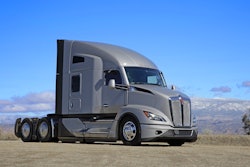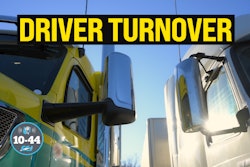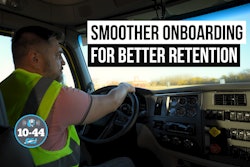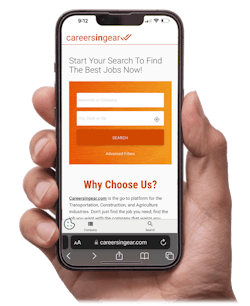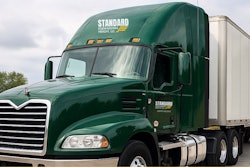Whether fleets are looking to fill seats due to a driver shortage or driver turnover, the fact is that those seats need to be filled. In order to do that, it’s important to understand who is driving trucks today and how to attract the next generation of truck driver.
The latest research from the American Transportation Research Institute dives into those issues and identifies not only the changes in truck driver demographics over the last two decades, but also relatively unexplored pathways into trucking careers and opportunities to bring more people into the industry.
[Related: Trucking workforce faces aging drivers, low youth interest, and underrepresentation of women]
Contents of this video
00:00 10-44 intro: Attracting new truck drivers
00:44 ATRI's research on driver demographics
02:16 Truck drivers are getting older
03:37 Strategies to attract younger truck drivers
04:50 The challenge of attracting women truck drivers
06:08 Success in improving racial diversity
06:58 New pathways: Former foster youth and justice-involved people
Matt Cole:
How truck driver demographics are changing and how fleets can attract new talent.
Jason Cannon:
Hey everybody. Welcome back. I'm Jason Cannon and my co-host is Matt Cole. Whether fleets are looking to fill seats, do a driver shortage or driver turnover, the fact is that those seats do need to be filled. In order to do that, it's important to understand who is driving trucks today and how to attract the next generation a truck driver.
Matt Cole:
The latest research from the American Transportation Research Institute dives into those issues and identifies not only the changes in truck driver demographics over the last two decades, but also relatively unexplored pathways into trucking careers and opportunities to bring more people into the industry.
Abbigail Huffman:
So back in March of 2024, our research advisory committee, which is about 35 different industry professionals, got together and identified two different priorities. The first being how have truck driver demographics evolved over the last few decades and how did we get to where we are today? The second priority is how can we think forward with our truck driver workforce? How can we be creative in trying to fill shortages as drivers retire? And so we identified ultimately two pathways, the first being people who were formally in the foster care system and then second folks who were justice involved at one point. So anybody who was on parole, probation, incarcerated in jail as potential opportunities for the industry to consider to invest in going forward. And there was just a lot of excitement from the research advisory committee. It was one of the top identified priorities. We ultimately did quite a few interviews with drivers, particularly on the justice involved side. We did interviews with fleets. We also did a survey with fleets and got some really great input on how that looks. We did a lot of data mining for this. We got some data from aida, the AIDA Foundation on different demographic trends over the years. We mined our own data to look at age, gender, employment classification, whether they were employee drivers or owner operators and independent contractors. So we just really opened up the gates and tried to get our hands on as much data to tell this story as we could.
Jason Cannon:
ATRI's research looked at a wide range of demographics, including age, gender, race, and a lot more. One finding that likely isn't a surprise to anybody is that truck drivers are getting older.
Abbigail Huffman:
We focused on five key demographics -- age, gender, racial, diversity, education, and then employment models. I'll start with age. There's no surprise here, have seen an aging workforce. It's something I feel like I've heard about since I've joined the industry back in 2022, about the average age is slowly increasing between 2008 and 2023, it went from 45 years old to 47 years old, and if you look at the report, that's government data. When you look at survey data, we're actually seeing higher averages. So people who are responding to our surveys are generally a little bit older in their fifties is the average, and so there's a dire need with an aging workforce to try to find creative ways to connect with younger folks in their twenties, their thirties. The average age for other trucking and transportation jobs oftentimes is in the thirties. So why are individuals, younger folks in the industry gravitating towards those employment opportunities than driving roles? You can get a class B or C, you can drive in trust state before you turn 21. There are opportunities out there in driving roles, but that's currently a missed opportunity in a lot of situations for the industry.
Matt Cole:
So what are some ways that fleets can attract those younger workers to become truck drivers?
Abbigail Huffman:
There's certainly a few things. Mentorship is absolutely a way to create those clear pathways. You don't know what you don't know if you see yourself in a driving role, but if somebody tells you, Hey, this is a place that you could really thrive, let me show you how I did it. Let me show you that clear pathway to become a driver and what it takes to get there. That's one way I think when you understand what it's actually like out there on the road, whether you're a local driver, regional OTR, no matter what it is, if you have somebody who you can quickly call upon as a mentor to just tell you what it's like is super important. I think it's also important for companies to have clear pathways. When somebody's applying for a job and they're coming in, they need to understand how their role fits in within the broader organization. If they see the critical role that drivers play in addition to the role that they play, it becomes a lot clearer how all these pieces work together. And they might go, Hey, maybe this is an opportunity for me. It's also a marketing thing. How are driving positions being marketed? If you ask your current drivers, what do you like about the work that you do and use that in the marketing material, that's a really great way to make sure you're getting the right type of people that fit within your organization.
Jason Cannon:
One demographic that trucking has struggled to attract in the truck driver's seat is women. They're vastly underrepresented as drivers when compared to other parts of the workforce.
Abbigail Huffman:
Three statistics for you -- 47% of the labor force is women. 12% of all employees in trucking are women. 4% of all truck drivers are women. And so there's definitely a gap. There's definitely an opportunity for the industry. And our research that we released last summer really highlighted a lot of the issues that drivers encounter, especially women. These are extra barriers sometimes that women are up against. And so a big part of that research was just having a conversation about some things that people weren't even aware of in the first place. Yes, I think harassment and discrimination are some of the more severe ones and the more talked about ones, but there's other issues too in terms of how do you make that adjustment to the OTR lifestyle? What is it like finding parking on a daily basis, finding safe parking on a daily basis? What about restroom access? There's a lot of things that just you and me and a lot of people listening we need on a daily basis, and how do you make sure that you set your drivers up to have those things? And in a lot of ways, I think that's why the percentage of women in the industry is unfortunately still quite low because something as simple as being able to go to the restroom is unfortunately a challenge for women out there on the road.
Matt Cole:
While there's still work to do to make trucking more attractive to women, the industry has done a good job in improving its racial diversity.
Abbigail Huffman:
I think one of the really big findings from this report is the acceleration in racial diversity. I know in recent years there's been a huge push for DEI -- diversity, equity and inclusion -- and I think this report really highlights that the industry has been quite successful. Back in 2014, the trucking industry was 77% white, just like the labor force today, only 63% of truck drivers are white, where the labor force still stands at 72%. So there's a nine percentage point difference between the trucking industry. So there's certainly been a lot of improvements in the diversification of the industry and just trying to really be inclusive and open arm to all different folks out there.
Jason Cannon:
The second part of ATRI's report looks at new pathways that trucking could tap into to increase its workforce -- former foster youth and justice-involved people, for example.
Abbigail Huffman:
Former foster care youth and justice-involved individuals. They all have very unique journeys, and it's important to look at each individual for what they are, not by the preconceived notions or any bias that you have that they each have a story, they each have a journey. They might've had some challenges along the way to just give them a chance. And both populations have some really great findings in there for how the industry can move forward. There's a lot of opportunities with how to try to connect with them in the first place. I think oftentimes we ask ourselves, well, where do I start? Where's the entrance point? And for foster care youth, they have a lot of educational challenges early on just because of oftentimes in school they're thinking about their home life. They're thinking about what they're going to eat that night. They're not thinking about the math equation that's on the board, and so automatically they have a lot of challenges when at school.
And so from a trucking industry standpoint, it's getting in contact with the school career readiness counselor or the social worker with, Hey, how can our trucking company fit into providing opportunities for these foster care youth? As far as the justice involved population, 57% of the fleets that we surveyed have hired a justice involved person in the last five years, and that's somebody who was incarcerated on parole probation. And so the industry is already fairly open-minded to this. Of course, there are restrictions with TWIC cards and different certifications you might need or credentials that you might need, but there's definitely some openmindedness in the industry and fleets that will actually target and try to recruit individuals who have that justice involvement.
Jason Cannon:
That's it for this week's 10-44. You can read more on ccjdigital.com. While you're there, sign up for our newsletter and stay up to date on the latest in trucking industry news and trends. If you have any questions or feedback, please let us know in the comments below. Don't forget to subscribe and hit the bell for notifications so you can catch us again next week.

